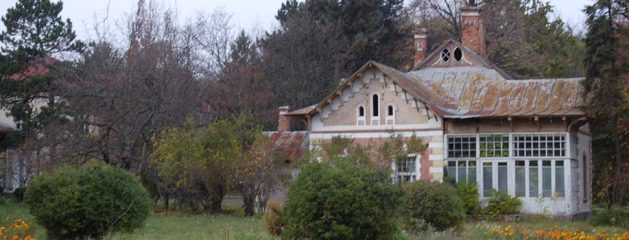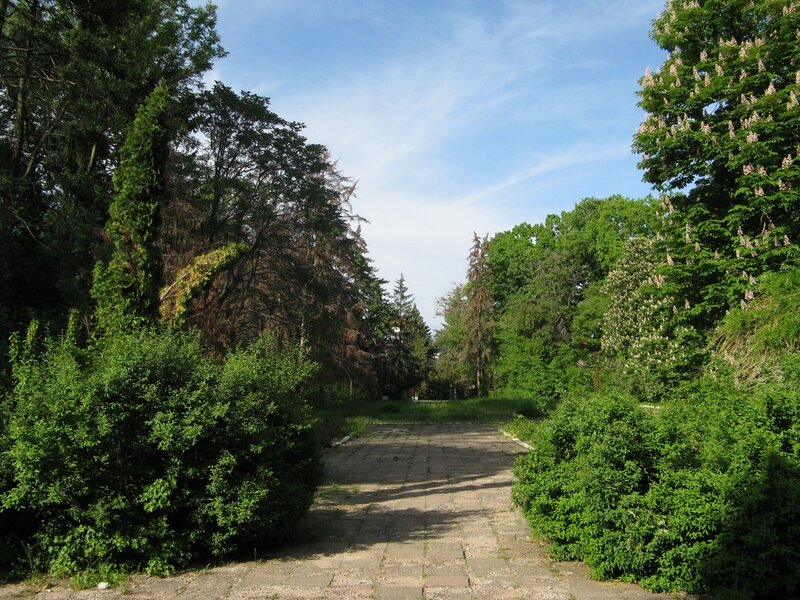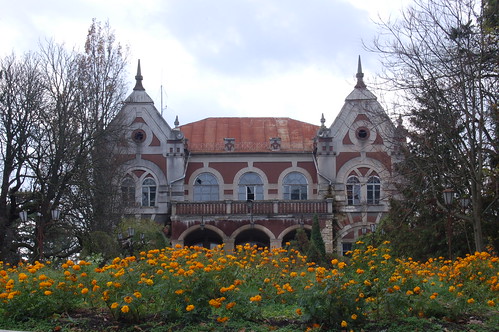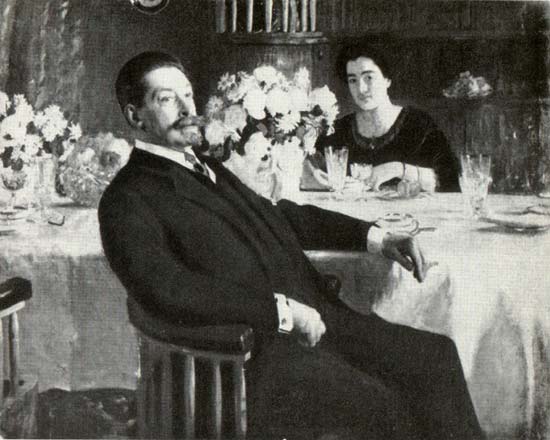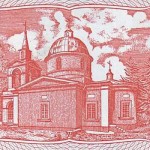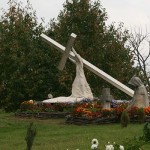Это место просто не может быть не окутано загадками. Достаточно бросить один взгляд на главное здание усадьбы в селе Цауль (Дондюшанский район), и сразу возникает масса вопросов. Кто построил это великолепие? Для чего? Кто жил в вольерах, над которыми — полуистертая надпись «Зоосад»? Кто заложил великолепный лесопарк? И есть ли клад? А он должен здесь быть, — само место обязывает, таинственное и необычное.
Поммер
С тех времен, когда в документах отыскалось первое упоминание о Цауле, а село тогда называлось «Алботень», в 1570-м году, конечно, ничего не сохранилось. Не строили здесь крепостей, не прорубали в недрах скал (а их здесь и нет) монастырей. Обычное село в живописном месте. Принадлежало оно 440 лет назад черновицкому старосте Албутэ. Видно, в честь него местность и была названа. Правда, в какое-то время у него вотчину конфисковали и сделали село господарским. Скандал разгорелся из-за убийства грека, которые пас овец в долине села Алботень, сам пастух был из соседней вотчины. Соотечественники убитого пожаловались господарю Богдану Лапушняну. Тот и наказал старосту за то, что такие беспорядки творятся у него на земле. Албутэ пришлось расплачиваться 158-ю коровами и волами, 600 овцами, 13 кобылами, — все это он отдал грекам, после чего господарь вернул Алботень прежнему хозяину. А долину, где произошло убийство, в народе стали называть Долиной Грека.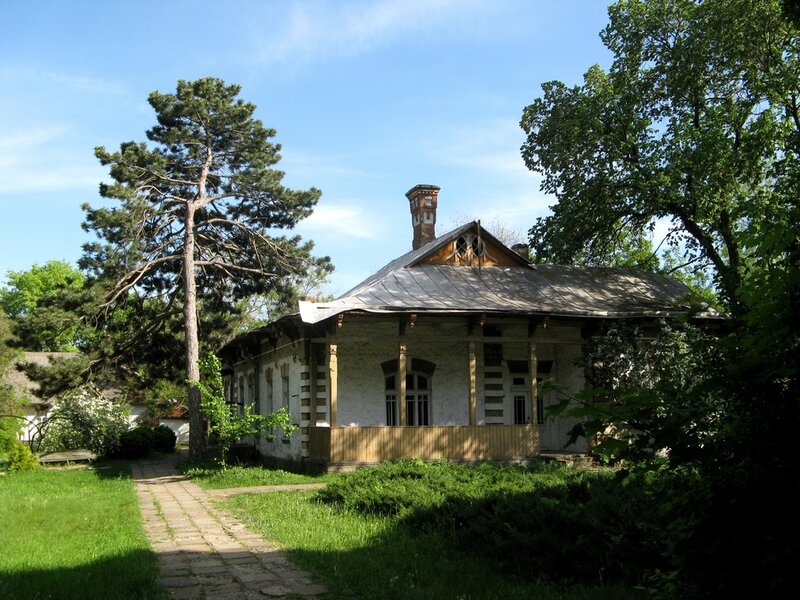
Впрочем, не исключено, что история села берет начало не с этого криминального происшествия, а гораздо раньше: в книге М.Констаческу «Молдавские документы периода до Штефана чел Маре» (1931г.) упоминается о том, что 13 марта 1429 года образовалось село Алботешть у истока речушки Сэрата. Идет ли речь о «предке» Цауля или нет, — можно только строить предположения. И радоваться: мы немного приоткрыли завесу одной из тайн, — возраста Цауля.
Загадочное место: то греков убивают, то тяжба происходит из-за вопросов владения. Это, правда, уже значительно позже случилось, в 1764 году, оспорили в суде богатеи, кто хозяин села. И монастырь владел Цаулем. А уже в середине 19-го века сюда съезжаются украинцы из Волынской и Подольской губерний. Понравилось им в молдавском селе, прижились они, привнеся сюда свою распевную речь, галушки и рушники, звонкие песни.

Но в чем тайны нет, так это в том, что село располагалось в живописном месте. Впрочем, в других местах Молдавского княжества села и не основывали. Выбирали территории поближе к источникам, к лесам, лугам. Поэтому не вызывает удивления тот факт – какая уж тут тайна – что санкт-петербургский и одесский финансист Андрей Яковлевич Поммер в 1900 году купил эти земли. К тому времени он уже 19 лет был женат на Александре Богдан (родилась в 1861 году) из Верхних Кугурешт Флорештского района. Семья Богдан владела Кугурештами с давних времен. Сестра Александры Евгения тоже вышла замуж за иностранца, за грека Апостопуло, и вместе с мужем поднимала вотчину Сахарна. Александра, а к моменту покупки Цауля ей было почти 40 лет, с супругом взялась за обустройство новых земель. И селение Цауль стало жить по-другому.
Лесопарк
Главный особняк выстроили в короткие сроки. Местные ходили смотреть, что за диковинный дом такой появился: отродясь они не видели такого строения. Разве что те, кто бывал в крупных городах, уж они-то могли порассказать соседям и не такое. В усадьбе появились хозяйственные постройки, крепкие одноэтажные строения, украшенные резным деревом, водонапорная башня, погреб, каменный забор. Были разбиты клумбы, а строения окружал красивый небольшой парк.

В Цауле устраивались вечера, приезжали гости, а местные неплохо зарабатывали на обслуживании господ. Но на этом супруги Поммер решили не останавливаться: вовсю шли работы по закладке лесопарка. Они начались вместе со строительными работами, но в отличие от возведения зданий, лесопарк требовал постоянной многолетней заботы. Хозяева пригласили для воплощения этой цели в жизнь украинского художника пейзажиста И.В.Падалко-Владиславского и местного садовода-виноградаря Якова Дмитриевича Войтова.
Шуточное ли дело: несколько десятков гектаров земли решили засадить привезенным с разных концов света растениями, сделать озеро и пруд. Различные участки лесопарка должны были воспроизводить растительность разных уголков земного шара. Впрочем, и сегодня это заметно: вот я шагаю по сибирской тайге, из нее попадаю в недра какого-то североамериканского леса, затем – в степь, оттуда – будто леса под Санкт-Петербургом, есть и молдавские зоны… Красота! Особенно впечатляет, когда стоишь чуть ниже главного дома усадьбы, а над лесопарком садится солнце. Если это еще и осенью, то картина такая, что трудно передать даже с помощью фотокамеры, — вид просто завораживает. В этом еще одна тайна этого места!
В 1925 году площадь лесопарка насчитывала уже 30 гектаров. К тому времени у усадьбы были другие хозяева: Андрей Поммер скончался в 1912 году, его супруга – неизвестно, в каком году умерла, но она после смерти мужа уехала в Санкт-Петербург. И она же с сестрой наведывалась в Верхние Кугурешты, где по их заказу и на их деньги сам Алексей Щусев строил церковь.
Зоосад и ресторан
В советские времена Цауль был чем-то вроде потемкинской деревни: на развитие этого населенного пункта тратилось много средств. Здесь часто бывали иностранные делегации, которым показывали, что и в молдавских селах народ живет не хуже, чем в городах. Да, Цауль стал «очень городским», где даже коровы на пастбища ходили по асфальту.
В старой усадьбе открыли дом отдыха, а в главном корпусе, похожем на дворец, — дом культуры. Позже огромный Дом культуры выстроили на улице, идущей перед парком усадьбы. Рядом с одной из хозяйственных пристроек основали зоосад, где жили птички, волки и даже, говорят, был мишка из бурых. Лесопарк содержали в образцовом порядке. Тем более, рядом с усадьбой построили сельскохозяйственный техникум, студенты которого часто работали в лесопарке. В техникуме учились студенты из стран бывшего соцлагеря и даже из далекой Африки.
В здании бывшей школы – она уже за забором усадьбы, на территории села, — открыли музей Цауля. Сегодня по дырявым крышам этого дома скачут белки, а дверь кажется навсегда закрытой. Вблизи музея – ресторан – невиданное дело для села, свой ресторан, — с остроконечной крышей, с «кружевным» деревянным оформлением. А перед забором усадьбы устроили «сельскохозяйственную» аллею, где установили бюсты известных ученых. Правда, Тимирязев уже без носа, а Лысенко, кажется, и вовсе головы лишился… не дожили…
Все-таки, умница был этот Поммер. Кто из жителей и гостей Цауля видел его портрет работы известного В. Кустодиева (1909 г.)? А усадьбу, лесопарк видят все, кто сюда приезжает. И запоминают надолго не только эти трогательные картинки, но и то ощущение нераскрытой тайны, которое хранит это место. И думают: «Какой же молодец этот Поммер, какой памятник себе на века сотворил!»
Наталья Синявская
Romanian version
Locul acesta, pur şi simplu, nu poate să nu fie învăluit de mistere. E suficient să aruncăm o privire la principala clădire a conacului din satul Ţaul, raionul Donduşeni, ca să apară mai multe semne de întrebare. Cine a ridicat frumuseţea asta? Pentru ce? Cine a locuit în volierele deasupra cărora mai este inscripţia aproape ştearsă “Menajerie”? Cine a creat minunatul parc? Şi dacă există o comoară? Trebuie să fie una aici, căci însuşi locul obligă, neobişnuit şi misterios cum pare.
Pommer
Desigur că n-a mai rămas nimic din timpurile când în documente a fost pomenit pentru prima oară satul Ţaul, care se numea pe atunci, în anul 1570, Alboteni. N-au fost ridicate aici nici cetăţi şi nici n-au fost făcute în stânci, care, de altfel nici nu există aici, mănăstiri rupestre. Este un sat ca toate satele, situat într-un loc pitoresc. Acum 440 de ani, localitatea a aparţinut primarului Albută. Probabil, în cinstea lui a şi fost numit satul, care, ce-i drept, i-a fost confiscat pentru o vreme, fiind în posesia domnitorului. Disputa s-a iscat din cauza uciderii unui grec care păştea oile în valea satului Alboteni şi care era din altă localitate. Consătenii celui omorât i s-au plâns domnitorului Bogdan Lăpuşneanu, care, la rându-i, l-a pedepsit pe primar pentru fărădelegea comisă pe pământul ţării lui. Albută s-a văzut nevoit să transmită grecilor drept răsplată 158 de vaci şi boi, 600 de oi şi 13 iepe, după care domnitorul i-a întors satul Alboteni vechiului stăpân, iar valea în care s-a întâmplat omuciderea a fost numită în popor Valea Grecului.
Totodată, nu putem exclude nici ipoteza că istoria satului a început nu cu această crimă, ci mai devreme. În cartea “Documentele moldoveneşti din perioada de până la Ştefan cel Mare” de M.Constacescu, anul 1931, este pomenit faptul că la 13 martie 1429 a apărut satul Alboteşti la izvorul râuleţului Sărata. Nu putem decât să facem supoziţii dacă e sau nu vorba de “strămoşul” satului Ţaul. Şi să ne bucurăm că am ridicat puţin vălul de pe unul din mistere, care este vârsta satului Ţaul.
Un loc enigmatic: ba pe greci îi omoară, ba tot felul de dispute judiciare în legătură cu proprietăţile. E adevărat că aceasta s-a întâmplat mai târziu, în anul 1764, când cei bogaţi au intentat un proces judiciar privind dreptul de a fi proprietarii satului. Ţaul a aparţinut până şi mănăstirii. La mijlocul secolului al XIX-a, aici vin ucrainenii din guberniile Volânia şi Podolia. Le-a plăcut satul moldovenesc şi s-au mutat cu traiul încoace, aducând cu ei limba lor melodioasă, găluştile, prosoapele şi cântecele lor răsunătoare.
Ceea ce nu constituie un mister este faptul că satul e situat într-un loc pitoresc. De altfel, în alte părţi ale Principatului Moldovenesc nici n-au fost fondate sate. Erau alese nişte terenuri care să fie mai aproape de izvoare, de păduri şi de păşuni. De aceea, nu trezeşte mirare faptul – ce enigmă mai poate fi şi aici – că Andrei Pommer, un magnat financiar în Sankt Petersburg şi Odesa, a cumpărat aceste pământuri în anul 1900, când el era deja de 19 ani căsătorit cu Alexandra Bogdan (născută în anul 1961) din Cuhureştii de Sus, raionul Floreşti. Familia Bogdan avea în proprietate satul Cuhureşti de mai demult. Eugenia, sora Alexandrei, s-a măritat şi ea cu un străin, grecul Apostopulo, şi a avut grijă împreună cu soţul de Saharna. Alexandra, care avea aproape 40 de ani la momentul cumpărării satului Ţaul, s-a apucat de rând cu soţul de amenajarea noii proprietăţi şi viaţa satului Ţaul s-a schimbat.
Parcul
Conacul a fost ridicat rapid. Localnicii mergeau să admire neobişnuita casă, căci ei nu văzuseră niciodată asemenea construcţii. Doar cei care au mai fost prin oraşele mari le puteau povesti şi despre lucruri mai ceva vecinilor. Pe lângă conac au apărut construcţii auxiliare temeinice cu un nivel, înfrumuseţate cu lemn gravat, un castel de apă, un beci, un gard de piatră, nişte răzoare şi un parc frumos nu prea mare împrejmuind toate aceste construcţii.
În Ţaul se organizau serate, veneau oaspeţi, iar localnicii câştigau destul de bine din deservirea domniilor lor. Soţii Pommer au decis să nu se oprească aici, ci să mai facă şi un parc mare cât o pădurice. De fapt, sădirea acestuia a început odată cu lucrările de construcţie a conacului, dar, spre deosebire de ridicarea caselor, parcul a necesitat mai mulţi ani de muncă. Pentru realizarea acestei idei, stăpânii i-au invitat pe I.V.Padalko-Vladislavski, un pictor de peisaje ucrainean, şi pe Iacov Voitov, un pomicultor şi viticultor local.
Nu era simplu să sădeşti pe o suprafaţă de câteva zeci de hectare de pământ plantele aduse din diferite colţuri ale lumii şi să mai faci şi un lac, şi un mic iaz. Diverse sectoare ale parcului trebuiau să reproducă vegetaţia mai multor locuri de pe planeta Pământ. Şi în ziua de astăzi se vede asta: iată, merg, de pildă, prin taigaua siberiană, din care nimeresc într-o pădure nordamericană, apoi, în stepă, iar de acolo, în nişte păduri ca lângă Sankt Petersburg, dar mai sunt şi zone moldoveneşti… Ce frumuseţe! E deosebit de impresionant când stai ceva mai jos de casa principală a conacului, în timp ce soarele apune deasupra parcului. Toamna e un tablou de nedescris chiar şi cu ajutorul camerei de fotografiat, căci panorama te vrăjeşte. Iată încă un mister al acestui loc!
În anul 1925, suprafaţa parcului constituia deja 30 hectare. La acel moment, conacul avea alţi stăpâni. Andrei Pommer a murit în anul 1912, iar soţia lui nu se ştie când a decedat, dar după moartea soţului, ea a plecat la Sankt Petersburg. Şi tot ea venea din când în când împreună cu sora ei la Cuhureştii de Sus, unde însuşi Alexei Şciusev a ridicat la comanda şi pe banii lor o biserică.
Menajeria şi restaurantul
În perioada sovietică, Ţaul era un fel de sat al lui Potiomkin, căci se cheltuiau sume mari de bani pentru dezvoltarea acestei localităţi. Satul era vizitat adeseori de delegaţii străine, cărora li se arăta că moldovenii de la ţară o duc nu mai rău decât cei din oraşe. Da, Ţaul a devenit “foarte urbanizat”, unde chiar şi vacile mergeau la păscut pe asfalt.
În conacul vechi a fost creată o casă de odihnă, iar în blocul principal, care seamănă cu un palat, o casă de cultură. Mai târziu, a fost ridicată o enormă Casă de Cultură pe strada din faţa parcului conacului. Alături de o construcţie auxiliară a fost făcută o menajerie, unde erau păsări, lupi şi se mai spune că era chiar şi un urs. Parcul era ţinut într-o stare exemplară, cu atât mai mult că lângă conac a fost construită o şcoală medie tehnică agricolă, a cărei studenţi lucrau de multe ori în parc. La şcoala agricolă învăţau studenţi din fostele ţări socialiste şi chiar din îndepărtata Africa.
În incinta fostei şcoli, care e deja după gardul conacului, adică pe teritoriul satului, a fost deschis muzeul din Ţaul. Astăzi, veveriţele se plimbă pe acoperişul găurit al acestuia, iar uşa pare închisă pentru totdeauna. În apropierea muzeului este un restaurant, ceea ce e mai puţin obişnuit pentru un sat, propriul restaurant cu un acoperiş cu vârful ascuţit şi acoperit exterior cu lemn “dantelat”. În faţa gardului conacului a fost făcută o alee “agricolă”, unde au fost puse busturile cunoscuţilor savanţi. Adevărat că Timireazev e deja fără nas, iar Lâsenco, se pare, nu mai are nici cap… n-au mai supravieţuit…
Totuşi, a fost bravo acest Pommer. Cine dintre locuitorii şi oaspeţii satului Ţaul i-a văzut portretul, executat de cunoscutul V.Custodiev (a.1909)? În schimb, conacul şi parcul au văzut toţi cei care vizitează această localitate. Şi nu uită nici farmecul lor şi nici acel sentiment de mister, pe care îl încearcă în acest loc. Şi se gândesc: “Ce bravo e acest Pommer, ce monument pentru secole şi-a creat!”
Natalia Sineavscaia
English version
Mystery of Taul Estate
This place cannot but nourish a feeling of mysteriousness. It is enough just to cast a glance at the main edifice of the manor in Taul settlement, Donduseni district, for plenty of questions to arise. Who has constructed this magnificent edifice? What for? What for living beings used to inhabit an open-air cage with an erased inscription “Zoological Garden”? Who has laid this splendid woodland park? Are there treasures hidden? And there must be treasures for the place itself suggests this by its mysteriousness and originality.
Pommer
Nothing has survived since the times when the settlement was first referred to in written documents under the name “Alboteni” in the year 1570. No fortress was ever constructed, no monastery was ever caved in a rock (the place sees no rocks). An ordinary settlement was laid in a picturesque place. 440 years back it belonged to Albuta, Superior of Cernovti settlement. The locality seems to have been first named in his honour. Although, once his estate was confiscated to be ceded to the ruler of the Moldovan Principality — the Gospodar. The reason of the quarrel was a murder of a Greek who used to shepherd sheep in the valley of Alboteni settlement, while the shepherd himself originated from a neighbouring estate. The countrymen of the deceased complained about the crime to the Gospodar Bogdan Lapusneanu. The latter punished the Superior for the disorder in his lands. Albuta had to atone for the crime 158 cows and bullocks, 600 sheep, 13 horses – all the assets we offered to the Greeks, afterwards the Gospodar redeemed Alboneti to its owner. While the valley that saw the murder was then renamed into the Greek Valley.
Although, the history of the settlement might have originated much earlier than the crime described above: the book of M. Constacescu “Moldovan Documents of Stefan cel Mare’s Epoch” (1931) mentioned that on 13th of March 1429 a settlement Albotesti was established by the head of the Sarata River. We may just suppose whether this is the forerunner of Taul settlement. Yet, one mystery of Taul’s age is half-opened.
The place is indeed mysterious: a murder of the Greek, a lawsuit on property rights. Although, the latter event took place much later, in the year 1764, when two rich landlords were arguing as to who was the owner of the settlement. Taul was also a part of the lands owned by a monastery. While in the middle of XIX century the Ukrainians from Volyn and Podolsk provinces settled in Taul. The Moldovan settlement came to the liking of the Ukrainians for them to get accustomed and to introduce their peculiar chanting speech, Ukranian dumplings and towels and melodious songs.
There is no mystery though as regards the placement of the settlement in a picturesque corner. On the other hand, only picturesque sights were selected to establish settlements in the Moldovan Principality. The locals selected places closer to water springs, forests, meadows. Therefore, there was no wonder – and there is no mystery about – that a financer from St. Petersburg and Odessa Andrei Pommer bought those lands in the year 1900. By this time he was married to Alexandra Bogdan (born in 1861) from Cuhuresti de Sus settlement, Floresti district, for already 19 years. The Bogdans’ Family owned Cuhuresti estate since remote times. Alexandra’s sister Eugenia was also married to a foreigner, a Greek Apostopulo and together with her spouse restored and developed Saharna estate. Alexandra, who by the moment of Taul purchase aged about 40 years, together with her spouse embarked on development of the new estate for Taul to see revival.
Woodland park
The central building was erected in no time. The locals came to admire that marvellous edifice: they never saw similar constructions before. Only those abstained, who chanced to visit large towns to have a lot of legends to share to their neighbours. The manor saw construction of auxiliary facilities: steady one-storey erections decorated with carved wooden patterns, a water tower, a vault, a stone fence. The landlords laid flower beds, while the buildings were surrounded by a small park.
Taul saw receptions with multiple guests for the locals to earn handsomely upon rendering serves to the nobility. The Pommers family did not stop thereon: the works on establishment of a woodland park were in full swing. In fact, the woodland park was laid at a time with the manor, yet in contrast to construction tree planting required constant long-term care. In order to realise that goal, the tenants invited a Ukrainian landscape designer Padalko-Vladyslavsky and local gardener-viticulturist Jacob Voytov.
The pending task was of large scale: to plant various species of flora transported from around the globe onto several dozens of hectares of land, to dig a lake and a pool. Various zones of the park were to reproduce the vegetation of various corners of the globe. Although, one is able to mark this at present: one roams about the Siberian Taiga to get to the deep North-American forest replaced by a steppe followed by forests as if originating from the outskirts of St. Petersburg, there are Moldovan zones either… It is magnificent! Especially striking is the sunset above the woodland park, which is better to admire from a position near to the main edifice. And should one chance to visit Taul autumn, no camera will render the scenery so fascinating it is. This is one more mystery of the place!
In the year 1925 the area of the woodland park covered 30 hectares. By that time the manor was owned by other tenants: Andrei Pommer passed away in the year 1912, there is no data as regards the date of decease of Alexandra Pommer, yet soon after the death of her spouse she left for St. Petersburg. She used to come back to Cuhuresti de Sus, where by the order and for the funds of the sisters, Alexei Shchusiev himself constructed a church.
Zoological garden and restaurant
In the soviet times Taul embodied a picture of “Potyomkin’s village”: a lot of funds were spent for the development of this settlement. It was often visited by foreign delegations to show-off that Moldovan villages offered conditions for residence no worse than in towns. Indeed, Taul grew into a rather “urban” village where even cows were grazing along paved streets.
In the old estate the authorities opened a health resort, while a recreation centre was opened in the main edifice reminiscent more of a palace. Later on, a huge recreation centre was constructed onto the street near the woodland park, while next to an auxiliary building a zoological garden was laid to provide shelter for birds, wolves and even a bear. The woodland park was duly attended. Moreover, an agricultural college was constructed near the estate for its students to have their practical activity in the woodland park. The college saw students from all around the USSR and even remote Africa.
In the building of the former school located beyond the boundaries of the estate the Museum of Taul settlement was established. Nowadays only squirrels jump onto the dilapidated roof of that building and its doors seem to be closed forever. Close to the museum there is a restaurant — a rather unusual establishment for a village – with sharp roof and intricate wooden patterns. While in front of the estate there was laid an “agricultural” alley to exhibit the monuments of famous scientists. Although, the statues look rather dilapidated either…
Meanwhile, Pommer has left a vivid natural monument for centuries. Who from residents and visitors of Taul has seen his portrait created by famous Boris Kustodiev in 1909? While the manor and the woodland park could be visited till nowadays by everyone who comes to the place. The visitors come to remember for long not only these magnificent sceneries, but also the feeling of some unrevealed mysteriousness preserved by the place.
Natalia Sineavscaia

